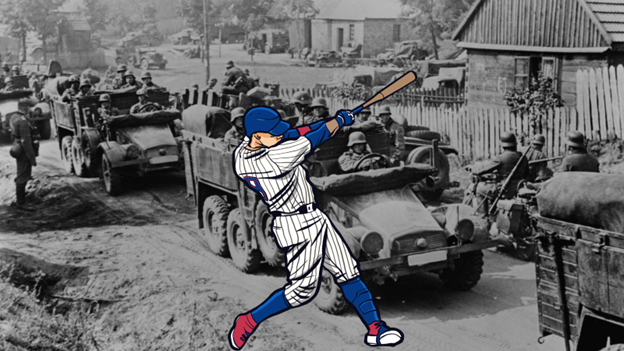

The Impact of WWII on Baseball: A Historical Perspective

Source: Canva
World War II had a big impact on baseball in the United States. This time period brought many changes to one of America's most popular sports. Major League Baseball (MLB) faced and overcame many challenges during the war.
Although 4,076 minor league players were drafted into military service, creating a gap in home entertainment, MLB's popularity surprisingly increased, even though the quality of play slightly declined.
The war years tested baseball's resilience as a business and paradoxically helped the sport grow. After the conflict, there was a significant increase in attendance, and the minor leagues expanded. In a landmark development in 1947, baseball broke the color barrier, becoming racially integrated.
During the war, the baseball community contributed to the war effort, and artifacts from this period are now housed at The Wright Museum, highlighting the significance of this era in baseball history.
Baseball not only survived the Great Depression and World War II but emerged from these challenges stronger and more integrated than ever before. Learn more about how these difficult times shaped modern American baseball...
Baseball Kept America's Spirits High During World War Two
During World War Two, baseball keeps people's spirits up in America. It was a mix of successes and setbacks - playing ball while also supporting the war effort.Major League Baseball had to deal with many issues during the war. Top players were drafted into the military, leaving teams shorthanded. Games and attendance suffered as a result.
Baseball's Rise in Fame
Baseball became very popular during World War II. People were looking for ways to have fun and forget about the war. So they turned to baseball. It became more than just a game. It was a way for families and friends to come together, cheer, and be happy.Soldiers overseas followed the games in any way they could. This made baseball the top sport in America in the 1940s.
Many people loved watching baseball games. It was not just about seeing the games in person. Baseball helped bring different people together during hard times. It was like going to a casino where everyone felt like one big group.
Back then, baseball gave people hope and helped unite them. It was more than just a fun sport to watch. Baseball was an important symbol that helped make bad times better.
Baseball's Business Challenges
The business of baseball faced hard times during World War II. Many players left to join the military. This shook up teams and leagues. The Major League Baseball was hit hard. But the smaller minor leagues were also affected.Back in 1901, these smaller clubs had joined together. They sorted out issues like who owned player contracts. Or how much fans should pay to see a game. These early efforts to manage baseball's business side were now put to the test. Professional sports had to deal with war and economic troubles.
This period pushed teams and league officials to get creative with marketing and labor relations. They had to keep games going, and stadiums filled. With fewer players due to many joining the war overseas, baseball management had to find new ways to draw crowds and make money. This was tough with nationwide rationing and travel limits.
There were many things to pay attention to in baseball during wartime. Teams had to keep the sport going while also helping with the war efforts.
How Did the War Impact Position Players' Stats?
World War II really shook up Major League Baseball. Many of the best players left to serve their countries. These meant teams had to bring up players from the minor leagues to fill their rosters. The level of play went down across all teams because of this. Batting averages dropped. There were fewer home runs hit. The quality of the games was not as good as before. Fans could tell that it was not quite the same baseball they loved.After the war ended in 1945, baseball began to get better again. When the veterans came back to play in the Major Leagues, the stats for position players improved. This time also set the stage for big changes in baseball history. In 1947, Jackie Robinson broke the color barrier and became the first Black player in the Major Leagues.
Robinson's success was important for more than just baseball. It challenged racial barriers in society. His great play also showed that integration could improve the performance metrics in the game. This marked a historic shift, not just for baseball, but for all sports in post-war America.
Conclusion
The impact of World War II on baseball was about more than just a game. It showed how sports can lift people's spirits during difficult times. Even with the challenges it faced, baseball came out stronger and helped unite America. The journey baseball took through the war years led to momentous changes. These included racial integration and more fans than ever before.During that time in history, baseball showed how it can bring folks together. This event proved baseball left a big mark on the sport and American culture.